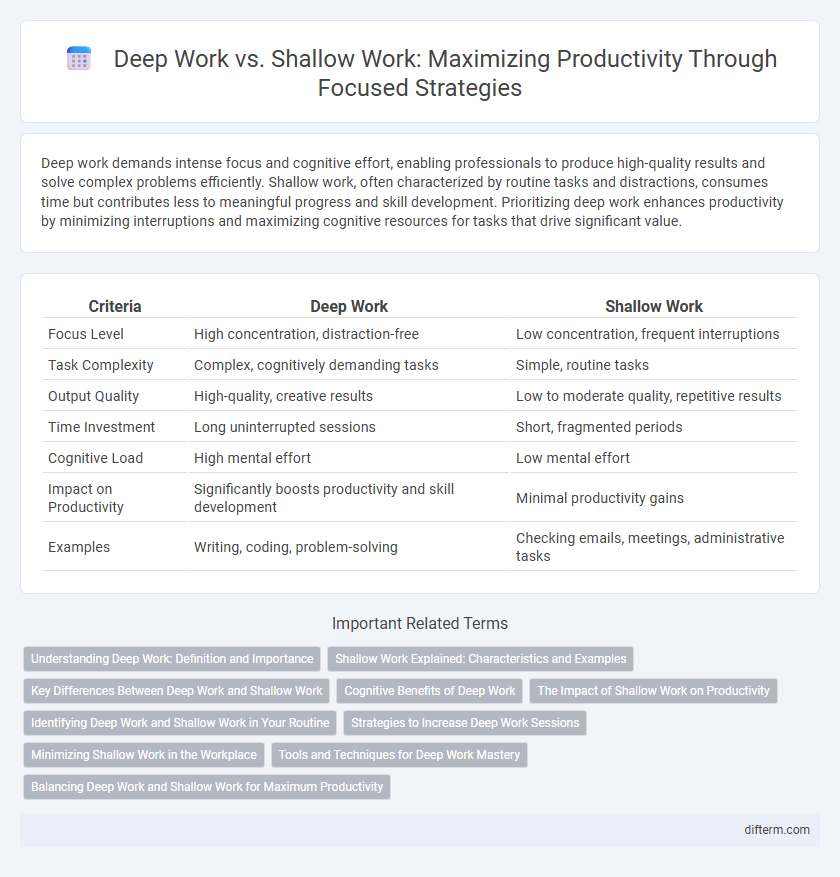Deep work demands intense focus and cognitive effort, enabling professionals to produce high-quality results and solve complex problems efficiently. Shallow work, often characterized by routine tasks and distractions, consumes time but contributes less to meaningful progress and skill development. Prioritizing deep work enhances productivity by minimizing interruptions and maximizing cognitive resources for tasks that drive significant value.
Table of Comparison
| Criteria | Deep Work | Shallow Work |
|---|---|---|
| Focus Level | High concentration, distraction-free | Low concentration, frequent interruptions |
| Task Complexity | Complex, cognitively demanding tasks | Simple, routine tasks |
| Output Quality | High-quality, creative results | Low to moderate quality, repetitive results |
| Time Investment | Long uninterrupted sessions | Short, fragmented periods |
| Cognitive Load | High mental effort | Low mental effort |
| Impact on Productivity | Significantly boosts productivity and skill development | Minimal productivity gains |
| Examples | Writing, coding, problem-solving | Checking emails, meetings, administrative tasks |
Understanding Deep Work: Definition and Importance
Deep work involves focused, distraction-free tasks that significantly boost cognitive capabilities and produce high-value outcomes. This type of work contrasts with shallow work, which consists of routine, low-concentration activities that often fragment attention. Prioritizing deep work enhances productivity by enabling complex problem solving and meaningful skill development.
Shallow Work Explained: Characteristics and Examples
Shallow work consists of non-cognitively demanding tasks that are often performed while distracted, such as responding to emails, scheduling meetings, and administrative duties. These activities are typically low-value in boosting productivity and do not require deep concentration or problem-solving skills. Examples include routine data entry, answering phone calls, and attending non-essential meetings, which contrast sharply with the intense focus required in deep work sessions.
Key Differences Between Deep Work and Shallow Work
Deep work involves focused, cognitively demanding tasks that enhance learning and creativity, while shallow work consists of low-concentration activities like emails and meetings that are often administrative or repetitive. Deep work produces higher quality output and drives significant progress on complex projects, whereas shallow work typically maintains day-to-day operations without contributing substantially to long-term goals. Prioritizing deep work over shallow work leads to improved productivity, enhanced skill development, and greater professional success.
Cognitive Benefits of Deep Work
Deep work enhances cognitive abilities by enabling sustained focus on complex tasks, which improves problem-solving skills and promotes deeper understanding. Engaging in deep work stimulates neuroplasticity, strengthening neural pathways associated with critical thinking and creativity. This focused approach leads to higher productivity and the ability to master challenging concepts efficiently.
The Impact of Shallow Work on Productivity
Shallow work, characterized by low-value tasks such as emails and administrative duties, significantly disrupts deep work by fragmenting attention and reducing cognitive capacity. This constant task-switching lowers overall productivity, leading to longer completion times and increased mental fatigue. Organizations that fail to minimize shallow work often see diminished innovation and lower quality outputs, as employees struggle to engage in focused, meaningful work.
Identifying Deep Work and Shallow Work in Your Routine
Deep work involves focused, cognitively demanding tasks like strategic planning, coding, or writing, which require prolonged concentration without distractions. Shallow work encompasses routine, low-value activities such as responding to emails, scheduling meetings, or administrative tasks that do not generate significant progress. Identifying deep versus shallow work in your routine helps prioritize high-impact projects and schedule uninterrupted time blocks to maximize productivity.
Strategies to Increase Deep Work Sessions
Maximizing productivity requires prioritizing deep work sessions by minimizing distractions and scheduling uninterrupted blocks of time for complex tasks. Techniques such as time blocking, setting clear goals, and using digital minimalism help enhance focus and cognitive capacity during these periods. Consistent practice of deep work strengthens mental resilience, enabling higher-quality output and faster skill acquisition.
Minimizing Shallow Work in the Workplace
Minimizing shallow work in the workplace enhances productivity by allowing employees to engage in more deep work, which involves focused, cognitively demanding tasks that drive significant results. Organizations that implement strategies such as blocking time for uninterrupted work, reducing unnecessary meetings, and automating routine processes see improved concentration and higher-quality output. Prioritizing deep work over shallow tasks ultimately leads to greater innovation, efficiency, and job satisfaction.
Tools and Techniques for Deep Work Mastery
Deep work mastery relies heavily on tools like time-blocking apps, noise-cancelling headphones, and distraction blockers to create an optimal environment for focused work. Techniques such as the Pomodoro method, single-tasking, and scheduled breaks enhance sustained concentration and cognitive performance. Leveraging digital minimalism and setting clear boundary rules for device usage further amplify deep work effectiveness and overall productivity.
Balancing Deep Work and Shallow Work for Maximum Productivity
Balancing deep work and shallow work is essential for maximizing productivity by dedicating focused, uninterrupted time to complex tasks while efficiently managing routine activities. Prioritizing blocks of deep work enhances cognitive performance and creative problem-solving, whereas shallow work, like emails and administrative tasks, supports daily workflow without overwhelming mental resources. Incorporating strategic breaks and clear boundaries between these work modes optimizes overall efficiency and reduces burnout.
Deep work vs Shallow work Infographic

 difterm.com
difterm.com